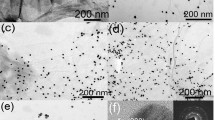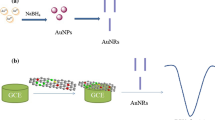Abstract
This study introduces a novel technique for detecting ascorbic acid (AA) using graphene oxide (GO). As a vital compound in nutrition and healthcare, precise sensing is imperative. Our approach leverages GO's unique properties, capitalizing on its interactions with AA as a reducing agent to establish a robust sensing platform. The UV–Visible spectra of GO revealed distinct absorption peak shifts corresponding to varying AA concentrations. This shift, directly proportional to AA concentration, offers a quantifiable parameter for precise sensing. The observed shift is attributed to AA-induced reduction of GO, restoring π-conjugation within the graphene structure. The US Department of Health and Human Services specifies that the vitamin C amount in our body ranges from 300 mg to 2 ( National Institutes of Health (NIH) Office of Dietary Supplements (ODS) US Department of Health and Human Services, Vitamin C Fact Sheet for Health Professionals, https://ods.od.nih.gov/factsheets/VitaminC-HealthProfessional/), which falls within the sensing range achieved using UV–Visible spectroscopy. The method prioritizes achieving sensitivity within the specific range, negating the need for excessively high sensitivity. In summary, our innovative GO-based approach provides a suitable method for ascorbic acid sensing with wide-ranging applications in clinical diagnostics, food quality control, and environmental monitoring.



Similar content being viewed by others
Data availability
Data will be made available on request.
References
S.J. Klebanoff, D.D. Dziewiatkowski, G.J. Okinaka, The effect of ascorbic acid oxidation on the incorporation of sulfate by slices of calf costal cartilage. J. Gen. Physiol. 42(2), 303–318 (1958)
B.A. Eipper, R.E. Mains, C.C. Glembotski, Identification in pituitary tissue of a peptide alpha-amidation activity that acts on glycine-extended peptides and requires molecular oxygen, copper, and ascorbic acid. Proc. Natl. Acad. Sci. 80(16), 5144–5148 (1983)
D. Jafari, A. Esmaeilzadeh, M. Mohammadi-Kordkhayli, N. Rezaei, Vitamin C and the immune system, in Nutrition and Immunity. ed. by M. Mahmoudi, N. Rezaei (Springer, Cham, 2019), pp.81–102
J. Du, J.J. Cullen, G.R. Buettner, Ascorbic acid: chemistry, biology and the treatment of cancer. Biochim. Biophys. Acta (BBA)-Rev. Cancer 1826(2), 443–457 (2012)
G. Hu, Y. Guo, Q. Xue, S. Shao, A highly selective amperometric sensor for ascorbic acid based on mesopore-rich active carbon-modified pyrolytic graphite electrode. Electrochim. Acta. 55(8), 2799–2804 (2010)
X. Wu, Y. Diao, C. Sun, J. Yang, Y. Wang, S. Sun, Fluorimetric determination of ascorbic acid with o-phenylenediamine. Talanta 59(1), 95–99 (2003)
L. Nováková, D. Solichová, P. Solich, Hydrophilic interaction liquid chromatography–charged aerosol detection as a straightforward solution for simultaneous analysis of ascorbic acid and dehydroascorbic acid. J. Chromatogr. AChromatogr. A 1216(21), 4574–4581 (2009)
T. Maki, N. Soh, K. Nakano, T. Imato, Flow injection fluorometric determination of ascorbic acid using perylenebisimide-linked nitroxide. Talanta 85(4), 1730–1733 (2011)
J. Kulys, E.J. D’Costa, Printed electrochemical sensor for ascorbic acid determination. Anal. Chim. Acta 243, 173–178 (1991)
T.M. Nancy, V.A. Kumary, Synergistic electrocatalytic effect of graphene/nickel hydroxide composite for the simultaneous electrochemical determination of ascorbic acid, dopamine and uric acid. Electrochim. Acta 133, 233–240 (2014)
S. Qiu, S. Gao, Q. Liu, Z. Lin, B. Qiu, G. Chen, Electrochemical impedance spectroscopy sensor for ascorbic acid based on copper (I) catalyzed click chemistry. Biosens. Bioelectron. 26(11), 4326–4330 (2011)
D. Wen, S. Guo, S. Dong, E. Wang, Ultrathin Pd nanowire as a highly active electrode material for sensitive and selective detection of ascorbic acid. Biosens. Bioelectron. 26(3), 1056–1061 (2010)
J. Aldabib, M. Edbeib, The effects of concentration based on the absorbance form the ultraviolet–visible (UV-VIS) spectroscopy analysis. Int. J. Sci. Lett. 2(1), 1–11 (2020)
M.L. Passos, M.L.M. Saraiva, Detection in UV-visible spectrophotometry: detectors, detection systems, and detection strategies. Measurement 135, 896–904 (2019)
A.A.A. Hassoni, A.S. Abbas, Cloud point extraction for the determination of copper (II) by UV-visible spectrophotometry. AIP Conf. Proc. (2022). https://doi.org/10.1063/5.0066811
J. Zhang, H. Yang, G. Shen, P. Cheng, J. Zhang, S. Guo, Reduction of graphene oxide via L-ascorbic acid. Chem. Commun. 6(7), 1112–1114 (2010)
N.I. Zaaba, K.L. Foo, U. Hashim, S.J. Tan, W.W. Liu, C.H. Voon, Synthesis of graphene oxide using modified hummers method: solvent influence. Proced. Eng. 184, 469–477 (2017)
A. Unnikrishnan, L.K. Alexander, Organic dye sequestration using Graphene Oxide-Activated Carbon (GOAC) composite unaided by a linker molecule. J. Mate. Sci.: Mater. Electron. 35(6), 417 (2024)
A. Unnikrishnan, L.K. Alexander, The concentration-dependent effect of NaOH on graphene oxide: revisited as a reducing agent. J. Phys. Chem. Solids 190, 111978 (2024)
I. Karnis, F. Krasanakis, L. Sygellou, A.N. Rissanou, K. Karatasos, K. Chrissopoulou, Varying the degree of oxidation of graphite: Effect of the oxidation time and the oxidant mass. Phys. Chem. Chem. Phys. (2024). https://doi.org/10.1039/D3CP05268K
S. Claramunt, A. Varea, D. Lopez-Diaz, M.M. Velázquez, A. Cornet, A. Cirera, The importance of interbands on the interpretation of the Raman spectrum of graphene oxide. J. Phys. Chem. C 119(18), 10123–10129 (2015)
S. Sunderrajan, L.R. Miranda, G. Pennathur, Improved stability and catalytic activity of graphene oxide/chitosan hybrid beads loaded with porcine liver esterase. Prep. Biochem. Biotechnol. 48(4), 343–351 (2018)
M. Palomba, G. Carotenuto, A. Longo, A brief review: the use of L-ascorbic acid as a green reducing agent of graphene oxide. Mater. 15(18), 6456 (2022)
N. Vidyarajan, L.K. Alexander, Strain induced optical properties of perovskite LaFeO3. Mater. Res. Expr. 6(1), 015610 (2018)
National Institutes of Health (NIH) Office of Dietary Supplements (ODS) US Department of Health and Human Services, Vitamin C Fact Sheet for Health Professionals. https://ods.od.nih.gov/factsheets/VitaminC-HealthProfessional/
D.J. Buckley, N.C. Black, E.G. Castanon, C. Melios, M. Hardman, O. Kazakova, Frontiers of graphene and material-based gas sensors for environmental monitoring. 2D Mater. (2020). https://doi.org/10.1088/2053-1583/ab7bc5
N. Rohaizad, C.C. Mayorga-Martinez, M. Fojtů, N.M. Latiff, M. Pumera, Two-dimensional materials in biomedical, biosensing, and sensing applications. Chem. Soc. Rev. 50(1), 619–657 (2021)
S.K. Ali, W.M. Alamier, N. Hasan, S. Ahmed, A. Ansari, M. Imran, Synergistic nanomaterials: zinc sulfide-polyaniline for ciprofloxacin electrochemical sensing. Appl. Phys. A 129(12), 859 (2023)
S. Ahmed, A. Ansari, S. Bishwanathan, M.A. Siddiqui, S. Tailor, P.K. Gupta, P. Ranjan, Electronic Tongue Based on ZnO/ITO@ glass for Electrochemical Monitoring of Spiciness Levels. Langmuir (2024). https://doi.org/10.1021/acs.langmuir.3c03763
S. Ahmed, A. Ansari, A.S. Haidyrah, A.A. Chaudhary, M. Imran, A. Khan, Hierarchical molecularly imprinted inverse opal-based platforms for highly selective and sensitive determination of histamine. ACS Appl. Polym. Mater. 4(4), 2783–2793 (2022)
Acknowledgements
This work was supported by the Kerala State Council for Science, Technology & Environment—SRS Project 107/2016. Both authors thank the Central Sophisticated Instrumentation Facility (CSIF), University of Calicut, Kerala, for providing FESEM facilities. The authors would also like to thank FIST2 (DST, Government of India) for providing the X-ray diffraction facility and UGC-SAP for the micro Raman facility in the Department of Physics, University of Calicut.
Funding
This work was supported by the Kerala State Council for Science, Technology and Environment-SRS Project 107/2016. The authors would also like to thank UGCSAP and FIST2 (DST, Government of India) for providing the research facilities in the Department of Physics, University of Calicut.
Author information
Authors and Affiliations
Contributions
Aruna Unnikrishnan contributed towards conceptualization; data curation; investigation; methodology; validation; visualization; formal analysis; and roles/ writing—original draft. Megha V contributed to the formal analysis. Libu K. Alexander contributed towards conceptualization; funding acquisition; supervision; methodology; validation; and writing—review and editing.
Corresponding author
Ethics declarations
Competing interests
The authors have no relevant financial or non-financial interests to disclose.
Additional information
Publisher's Note
Springer Nature remains neutral with regard to jurisdictional claims in published maps and institutional affiliations.
Supplementary Information
Below is the link to the electronic supplementary material.
Rights and permissions
Springer Nature or its licensor (e.g. a society or other partner) holds exclusive rights to this article under a publishing agreement with the author(s) or other rightsholder(s); author self-archiving of the accepted manuscript version of this article is solely governed by the terms of such publishing agreement and applicable law.
About this article
Cite this article
Unnikrishnan, A., Megha, V. & Alexander, L.K. Ascorbic acid sensing utilizing graphene oxide based on UV–Visible bathochromic shift. J Mater Sci: Mater Electron 35, 904 (2024). https://doi.org/10.1007/s10854-024-12672-8
Received:
Accepted:
Published:
DOI: https://doi.org/10.1007/s10854-024-12672-8




